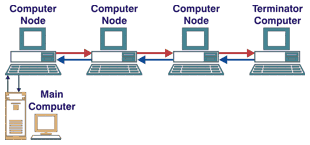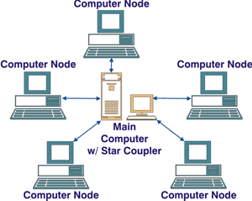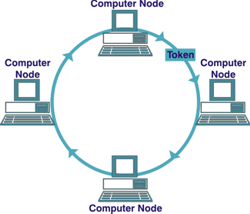

There are two basic categories of network topologies:
The actual cable as hung on poles or buried in the ground, and used to link devices together at disparate geographical locations is the Physical Topology. To determine the physical topology, considerations include network requirements, and distance and fault tolerance level versus the cost associated with actual construction of the fiber.
In contrast, the Logical Topology is very different. It affects how the individual fibers or circuits act without regard to pathway or fault tolerance.

A bus network topology, also called a daisy-chain topology has each computer directly connected on a main communication line. One end has a controller, and the other end has a terminator. Any computer that wants to talk to the main computer must wait its turn for access to the transmission line. In a straight network topology, only one computer can communicate at a time. When a computer uses the network, the information is sent to the controller, which then sends the information down the line of computers until it reaches the terminating computer. Each computer in the line receives the same information. A bus network with a backbone operates in the same fashion, but each computer has an individual connection to the network. A bus network with a backbone offers greater reliability than a simple bus topology. In a simple bus, if one computer in the network goes down, the network is broken. A backbone adds reliability in that the loss of one computer does not disrupt the entire network.

Most – but not all – of our customers use Star or Point-to-Multipoint topology, although some enterprise customers will occasionally employ this design as well. In this scheme, there is a centralized Hub (or building) from which each circuit originates, with the end of the circuit in each of the various remote locations. Just like a star, each circuit starts in the middle and ends at the edge. This could be described as multiple Single Point-to-Point circuits, all originating at the same point or location.

Ring Topology operate like bus networks with the exception of a terminating computer. In this configuration, the computers in the ring link to a main communication cable. The network receives information via a "token" containing information requested by one or more computers on the network. The token passes around the ring until the requesting computer(s) have received the data. The token uses a packet of information that serves as an address for the computer that requested the information. The computer then "empties" the token, which continues to travel the ring until another computer requests information to be put into the token.
An advanced version of the ring network uses two communication cables sending information in both directions. Known as a counter-rotating ring, this creates a fault tolerant network that will redirect transmission in the other direction, should a node on the network detect a disruption. This network uses fiber optic transceiver, one controlling unit in set in "master" mode along with several nodes that have been set as "remote" units. The first remote data transceiver receives the transmission from the master unit and retransmits it to the next remote unit as well as transmitting it back to the master unit. An interruption in the signal line on the first ring is bypassed via the second ring, allowing the network to maintain integrity. Figure 6 illustrates this configuration as it might be used in a ITS installation.





























































































































 Sage Pastel has streamlined our financial operations. We have achieved stability with the system now and are satisfied with your support.
Sage Pastel has streamlined our financial operations. We have achieved stability with the system now and are satisfied with your support.
-Principal
Institute of Social Works
 I would like to thanks and congratulate to you and your team who has performed very nice and swift action to fulfil this project in less time and efficient way.
I would like to thanks and congratulate to you and your team who has performed very nice and swift action to fulfil this project in less time and efficient way.
-CEO
Capital Markets and Securities Authority (CMSA)
 I have been impressed with your level of technical ability and the ease with which we can work together. I will certainly be recommending Web Technologies to others who need fast and well delivered applications.
I have been impressed with your level of technical ability and the ease with which we can work together. I will certainly be recommending Web Technologies to others who need fast and well delivered applications.
-Executive Director
Tanzania Education Authority (TEA)
 We are very happy with the service Web Technologies provides. They are contactable twenty four hours a day, seven days a week and their response times are excellent, which keeps our down time to a minimum.
We are very happy with the service Web Technologies provides. They are contactable twenty four hours a day, seven days a week and their response times are excellent, which keeps our down time to a minimum.
-Johannes Kahwa
It Manager, Social Security Regulatory Authority ( SSRA)
 Web Technologies have been overseeing the development of our University Website , Software and networks for over 5 years. Work is always completed to a high standards, on time and to budget. We have been very appreciative of the patient, friendly and reliable service.
Web Technologies have been overseeing the development of our University Website , Software and networks for over 5 years. Work is always completed to a high standards, on time and to budget. We have been very appreciative of the patient, friendly and reliable service.
-Elibariki Mushi (Head of ICT)
Kampala International University (KIU)
Terms of Service | Terms of Use | Privacy Policy | Connectivity
Articles | FAQ | Sitemap | Inquiry | Client Speaks | Contact | Blog | Partnership



Social Network Marketing